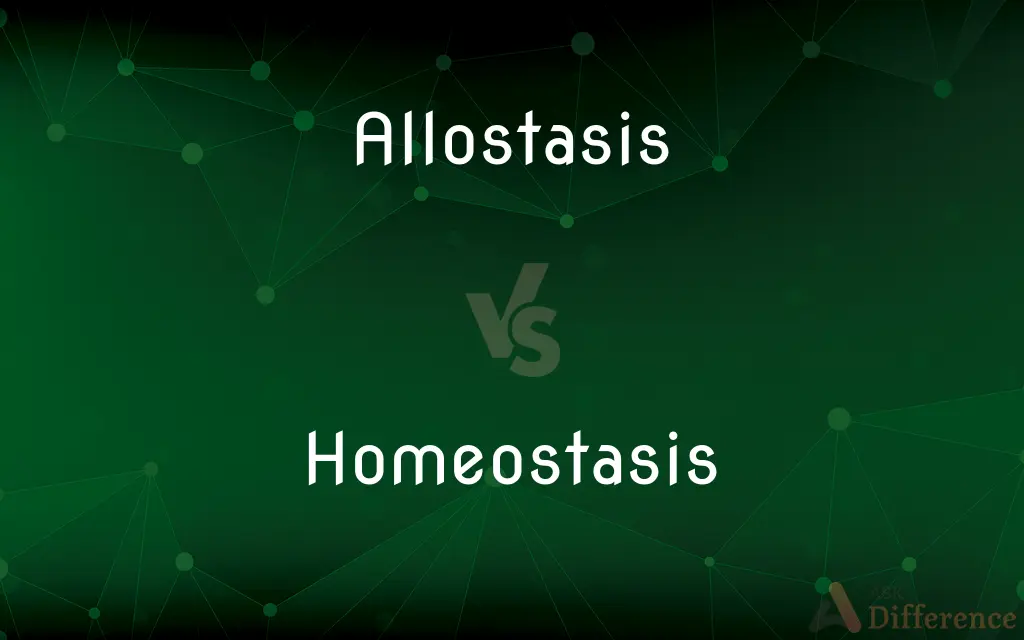Allostasis vs. Homeostasis — What's the Difference?
By Tayyaba Rehman — Updated on September 28, 2023
Homeostasis maintains internal stability via constant conditions; Allostasis achieves stability through physiological or behavioral change in response to environmental demands.

Difference Between Allostasis and Homeostasis
Table of Contents
ADVERTISEMENT
Key Differences
Allostasis and Homeostasis are physiological concepts denoting the body's response mechanisms to maintain internal stability. Homeostasis refers to the process by which the body maintains a stable internal environment, keeping various physiological parameters—such as temperature, pH, and salinity—within narrow limits. It’s a regulatory mechanism ensuring constancy in the body's internal environment despite external changes. On the other hand, Allostasis implies achieving stability through change, where the body adapts to stress or perceived threats by altering its physiological parameters to meet environmental demands.
While homeostasis aims to maintain equilibrium by resisting change and continuously adjusting to deviations, allostasis involves a proactive adjustment of body parameters in anticipation of or in response to changes in the environment. Homeostasis utilizes feedback loops to monitor and regulate internal conditions, restoring equilibrium when they deviate from set points. Allostasis, however, represents the adaptive changes the body makes in anticipation of environmental demands, involving a set of responses that may vary based on stress, activity levels, and perceived challenges.
In practical terms, homeostasis keeps the body’s internal systems in balance, preventing deviations from the optimal conditions necessary for survival, while allostasis allows the body to achieve stability through changes, adapting to new environmental conditions and stressors. The difference between maintaining balance and achieving stability through change is crucial for understanding the body's adaptive responses to the environment and how they affect health. While homeostasis is essential for survival, enabling the body to function within a stable range, allostasis helps the body to adapt to changes, ensuring survival under varied and changing conditions.
Allostasis and homeostasis are critical components of the body's adaptive mechanisms, and both have significant implications for health. A failure in homeostatic mechanisms can lead to imbalances and disease states, while inadequate or excessive allostatic responses can result in wear and tear on the body, termed as "allostatic load," leading to chronic stress and related health conditions. Understanding these concepts can provide insight into how the body maintains stability and adapts to its environment, revealing implications for managing stress, health, and disease.
Comparison Chart
Definition
Achieving stability through physiological or behavioral change.
Maintaining internal stability via constant conditions.
ADVERTISEMENT
Mechanism
Proactive adjustment to environmental demands.
Resistive regulation to maintain equilibrium.
Objective
Adaptation to stress and environmental changes.
Maintenance of optimal and constant internal conditions.
Impact on Health
Allostatic load can lead to chronic stress conditions.
Failure can lead to imbalances and disease states.
Relationship with Environment
Interaction and change in response to environmental variation.
Resistance to environmental change to maintain internal constancy.
Compare with Definitions
Allostasis
The body's response mechanism to maintain stability through change, especially under stressful conditions.
Allostasis involves complex responses to help the body cope with different stress levels.
Homeostasis
The body's mechanism for maintaining internal stability by resisting environmental changes.
Homeostasis ensures that our body’s internal environment remains constant despite external fluctuations.
Allostasis
The process by which the body achieves stability through physiological or behavioral change in response to environmental demands.
Allostasis enables the body to adapt to stress by altering physiological parameters.
Homeostasis
A self-regulating process by which biological systems maintain equilibrium.
Homeostasis is integral to maintaining balance in bodily functions, such as blood pH levels.
Allostasis
A dynamic regulation mechanism allowing adaptation to environmental changes and stressors.
Through allostasis, the body adjusts its physiological processes to meet the demands of varying environments.
Homeostasis
The regulation of the internal environment to maintain constant conditions.
Homeostasis is vital for maintaining the body's temperature within a narrow range.
Allostasis
Adaptive modulation of physiological set points in anticipation of or in response to environmental changes.
Allostasis is crucial in scenarios where the body needs to modify its functions in response to stress.
Homeostasis
The dynamic equilibrium maintained by the body's internal physiological processes.
Efficient homeostasis is crucial for the optimal functioning of the body's various systems.
Allostasis
A mechanism for achieving stability and balance in the body by actively adjusting to perceived threats and environmental changes.
Effective allostasis enables individuals to better handle the pressures and changes in their environments.
Homeostasis
The ability of an organism to maintain internal balance and stability, compensating for environmental changes.
Homeostasis keeps the concentrations of electrolytes in the body fluids constant, ensuring proper cellular function.
Allostasis
Allostasis proposes that efficient regulation requires anticipating needs and preparing to satisfy them before they arise, as opposed to homeostasis, in which the goal is a steady state.
Homeostasis
In biology, homeostasis is the state of steady internal, physical, and chemical conditions maintained by living systems. This is the condition of optimal functioning for the organism and includes many variables, such as body temperature and fluid balance, being kept within certain pre-set limits (homeostatic range).
Allostasis
The process of achieving stability, or homeostasis, in the body, through physiological or behavioral change.
Homeostasis
A state of equilibrium, as in an organism or cell, maintained by self-regulating processes
The kidneys maintain homeostasis in the body by regulating the amount of salt and water excreted.
Homeostasis
(physiology) The ability of a system or living organism to adjust its internal environment to maintain a state of dynamic constancy; such as the ability of warm-blooded animals to maintain a stable temperature.
Homeostasis
Such a dynamic equilibrium or balance.
Homeostasis
The ability and tendency of certain systems to maintain a relatively constant internal state in spite of changes in external conditions; this ability is achieved by the presence of feedback mechanisms which can adjust the state of the system to compensate for changes in the state caused by the external environment. It is exemplified in homeothermal biological systems, such as animals which maintain relatively constant blood temperature and composition in spite of variations in external temperature or the composition of the food ingested.
Homeostasis
Metabolic equilibrium actively maintained by several complex biological mechanisms that operate via the autonomic nervous system to offset disrupting changes
Common Curiosities
Does homeostasis resist changes to maintain internal balance?
Yes, homeostasis resists environmental changes to maintain equilibrium in the body's internal environment.
Are Allostasis and Homeostasis the same?
No, while homeostasis maintains constant internal conditions, allostasis achieves stability through changes in response to the environment.
Does allostasis help in adapting to stress and environmental changes?
Yes, allostasis allows the body to adapt to stress and environmental changes by altering physiological or behavioral aspects.
Is allostasis proactive in dealing with environmental demands?
Yes, allostasis involves proactive adjustments of body parameters to meet environmental demands and stressors.
Can failure in homeostasis lead to disease states?
Yes, a failure in homeostatic mechanisms can lead to imbalances and various disease states.
Share Your Discovery

Previous Comparison
Tactic vs. Method
Next Comparison
Man vs. MaleAuthor Spotlight
Written by
Tayyaba RehmanTayyaba Rehman is a distinguished writer, currently serving as a primary contributor to askdifference.com. As a researcher in semantics and etymology, Tayyaba's passion for the complexity of languages and their distinctions has found a perfect home on the platform. Tayyaba delves into the intricacies of language, distinguishing between commonly confused words and phrases, thereby providing clarity for readers worldwide.
















































